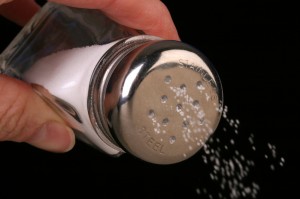My article regarding the moving story of Ben Breedlove, who succumbed at the age of 18 after a long fight with Hypertrophic Cardiomyopathy, Christmas Day 2011 (please click on the photo to read the article on FoxNews.com):

Category Archives: HC Update
Classic Wisdom: Jack Lalanne on the Mind/Body Connection, ca. 1960
The legendary health, diet and exercise pioneer communicates an enduring message across the decades.
Video: What Determines Our Health?
Product of the Week
New Guidelines for Fighting Obesity and Heart Disease in Children
There are new recommendations on cholesterol screening, and much more, just issued by the National Heart, Lung and Blood Institute (NHLBI). Their mission is clear from the document’s title: “Cardiovascular Risk Reduction in Children and Adolescents: The New NHLBI Guideline.”
mission is clear from the document’s title: “Cardiovascular Risk Reduction in Children and Adolescents: The New NHLBI Guideline.”
The document is in direct response to the alarming proportion of children who have markedly abnormal cholesterol levels and evidence of atherosclerosis – a disease normally thought of as an adult medical problem. These recommendations are designed to help reverse the epidemic of obesity and the related diseases that are growing at an alarming rate in our children.
At the November 2011 American Heart Association Convention in Orlando, as I observed the NHLBI presentation about these new and much-anticipated recommendations for preventing heart disease in children, I looked around at the sparsely-filled room. It was set up with seats to accommodate 600 professionals. There were fewer than 200 in attendance. Perhaps this was because it was an evening presentation, or maybe it reflects physician frustration at the enormity of the public-health issue of obesity, with its secondary problems of hypertension, hypercholesterolemia and resultant heart disease.
In any case, the guideline document needs to be widely disseminated within the medical community.
The comprehensive NHLBI review began with a computer-generated initial list of 1 million articles. The final document incorporated the best-of-the-best research on the topic, representing a derived-consensus document.
These are the significant take-away points:
- High cholesterol in children is related to the development of heart disease in the adult.
- With the obesity epidemic, cholesterol levels are rising even higher. Reduction in obesity will lower cholesterol levels.
- Early intervention is needed for hypercholesterolemia and poor health habits in children (the behaviors as well as the diseases continue into adulthood).
Initial management for abnormal serum cholesterol is education about healthy diet and exercise. - Healthy diet-education is best handled with the entire family involved and a dietitian.
- Examples of healthy diet include the DASH diet and the Mediterranean diet.
- There should be universal screening for elevated cholesterol for ages 9-11 years.
- There should be earlier screening for high-risk individuals.
- Medications may be needed in about 1percent of children (upwards of 200,000 children).
- Parents must increase the activity level of children and reduce TV and computer time. The recommended activity level for 5 years and older is one hour of moderate to vigorous exercise per day.
Quite simply, this list should be posted in every pediatric physician’s office across the United States.
Video: The Watanabe Rabbits
The Top 10 Reasons Why School Sports are Unhealthy
I believe that high school sports, and behaviors related to school athletics, are fostering obesity,  eating disorders and illness in America. Here is my Top 10 List of reasons why school sports are – counter-intuitively – leading to bad habits and worse health for America’s young people.
eating disorders and illness in America. Here is my Top 10 List of reasons why school sports are – counter-intuitively – leading to bad habits and worse health for America’s young people.
1) Rapid weight-gain in childhood is associated with life-long obesity and heart disease. Bad behaviors that are associated with school athletics include bulking up for football, dropping and gaining weight for wrestling, and ultra-thin eating habits, leading to anorexia in young gymnasts.
2) The concept that, “You’re an athlete – you’re working out, so you can eat whatever you want to eat,” promotes consumption of junk foods, which also extends to the spectators who consume junk foods sold at sporting events.
3) Teaching the concept that endurance and intense aggressive training is a healthy lifestyle – “no pain, no gain” – reduces the likelihood that voluntary athletic behavior will continue into adulthood.
4) If “winning isn’t everything, it’s the only thing” as the goal in sports participation, then inevitably there will be many losers. Ultimately this concept becomes a psychological negative when one thinks of health and its relationship to exercise.
5) Lengthy afterschool practice sessions, combined with late-evening competition in Junior Varsity team sports, leads to missed hours of sleep, a drop in metabolism and a propensity toward obesity.
6) Head injuries in soccer and hockey, as well as football concussions, are becoming a common cause of extended illness in young people.
7) Repetitive damage to joints results in long-term disability, including back, knee and hip disease.
8) This results not only in limiting one’s ability to ambulate as an adult, but subsequently results in weakened cardio-pulmonary function due to a lack of mobility, thereby increasing the likelihood of obesity, hypertension, diabetes, heart disease and stroke.
9) Sadly, school athletics encourage the culture of drugs: Taking stimulants for added stamina, including energy drinks such as Red Bull, often leads to the accepted use of steroids and other harmful and/or prohibited substances.
10) The overriding concept that winning is the most important part of the game is perhaps the umbrella theme promoting all the other unhealthy behaviors that affect today’s young athletes.
Making Health Connections: Family-Centered Care
The new wave in medicine is family-centered care. The journal “Dimensions of Critical-Care Nursing” just published an article titled, “Goal of the Day: Initiating Goal of the Day to Improve Patient- and Family-Centered Care.” But just what is family-centered care, and who are the family members? Is it the classic family unit, or is it much more?
 It has been well documented that, with ailing patients, human or animal connections improve health.
It has been well documented that, with ailing patients, human or animal connections improve health.
In women diagnosed with terminal breast cancer, simply meeting regularly with other women in a similar disease-state improved outcomes.
Talking and connecting with other women resulted in a doubling of life expectancy – a result that could not be achieved by any known medical intervention.
Walkers of dogs have less incidence of heart disease and are more adept at surviving heart attacks. Even observation of animal behavior can achieve dramatic results in treating and potentially curing some forms of autism and Asperger syndrome. This phenomenon was illustrated by anthropologist Dawn Prince-Hughes, M.A., Ph.D., in her book “Songs of the Gorilla Nation: My Journey through Autism.” The book chronicles her journey from social isolation and homelessness as an Asperger sufferer to her emergence as a world-renowned researcher. Prince-Hughes attributes her dramatic personal transformation to her early experiences observing and interacting with gorillas at the Woodland Park Zoo in Seattle, Wash., where she was employed as a young adult.
While some of her subsequent conclusions concerning primate behavior are inevitably controversial, the researcher’s life story is itself an important demonstration of one kind of transformative health connection.
Vitamins, Vitamins – Everywhere!
Food for Thought…
Vitamins, vitamins, everywhere! Given the excess availability of vitamins as supplements and as dietary fortification in a vast number of foods, is it possible that we are poisoning ourselves with excessive intake of vitamins?
A vitamin, by its very definition, is needed in our bodies in minute quantities. So why are vitamins added to so many of our daily foods?
The food industry has added vitamins and minerals to a broad spectrum of our foods to make up for the damage (i.e., the stripping of nutrients) that occurs in the sometimes radical processing of foodstuffs. In addition, “vitamin fortification” has been used as a marketing ploy to give essentially bad or empty-calorie foods the illusion of being healthy for the consumer. To make things even worse, the vitamin hype feeds into the psychological trap that lures the consumer into thinking, “if a little is good for you, then more must be even better!” Now evidence is growing that too much supplementation may increase one’s chance of aging faster and dying earlier, according to a recent study released in the Archives of Internal Medicine.
Read more: http://www.foxnews.com/health/2011/10/14/are-your-supplements-killing/#ixzz1boqyTbYM
But back to the ploy of “fortifying foods with vitamins and minerals,” which, since the hugely successful marketing campaigns of the 1960s aimed at the parents of growing Baby Boomers, has become universal and excessive.
Cereals and food bars with more than 100 percent of your daily needs are now quite common. When I look at the ingredient list on the label of one of these products, I have to question whether one is about to consume some form of cereal, or Pop Tarts, or simply a large multivitamin.
In my last article, I pointed out the problems of multivitamin consumption in the diets of our older population. If our food industry continues to manipulate the vitamin and mineral content of the foods we eat, in the sometimes dramatic fashion I have described, we will begin to see the same negative effects of excessive fortification, such as too much iron and calcium, in the general-population’s diet as we now see resulting from over-supplementation in the diets of our older consumers.
- Studies have revealed that supplementing vitamins A, E, and C as well as Omega 3 does not yield the same benefits that are obtained when they are consumed in natural sources. Now more evidence of the toxic effects of excessive supplement and vitamin consumption, coupled with scarce documentation to support such large intake, makes the case that not only is natural better, but modified or fortified may be bad. Fortunately, the health benefits are dramatic when vitamins and supplements are obtained in a natural state.
Following are some examples of this.
- The Mediterranean Diet
- Nuts
- Vegetables (dark green veggies are the anti- obesity, anti-diabetes, anti-hypertension and anti-ADHD natural food)
Holistic Approaches
 Caution! Reading this article may be detrimental to your health.
Caution! Reading this article may be detrimental to your health.
Indeed, if you are sitting still while reading this article, you may be increasing your risk of heart attack, stroke, obesity, diabetes and many other diseases.
So – what course of action does the doctor prescribe?
First, you can put down the article, or turn off the computer, and stop reading. Or, in these days of modern technology, you could begin reading while walking, gaining intellectual enlightenment by using a handheld text-retrieval device, or even by listening to an audio version or podcast download of the book or article of your choice.
Try reading while on an exercise bike or tread mill. This can be an efficient use of time (combing exercise with reading). Simple changes in our lifestyle can take us from the sedentary, obesity- and heart attack-prone environment to a world of health through movement.
“The Saving America Series” presents creative uses of technology that can be adopted as a bridge to physical, emotional and economic health. This dynamic series also challenges everyone to participate in a needed renaissance of American health culture. We must do more to engage our youth explore new and innovative ways to promote physical, emotional and financial health, harnessing the energy of our youth without forgetting the wisdom of our parents and ancestors.
The time has come for us to embrace the willingness of young Americans to think differently and to view the world in innovative ways.
We propose leveraging all of our attributes as an advanced nation to encourage individuals throughout this country to submit ingenious ideas and concepts, to engage with technical schools, colleges, universities to begin exploring the problems of our national health culture, and to begin finding targeted, common-sense solutions to the health crises we face.
The goal is to prevent illness by using technology applications in ways as dramatic as those used in curing illness after the fact. This must be the medical community’s new mantra. No longer can the community of physicians be separate from the public health sector. We should be looking at preventive alternatives to performing costly procedures like open-heart surgery, placing stents or doing bypass operations, when an early change in the elements of an individual’s everyday lifestyle could achieve the same or better results.
High Cholesterol in Children: To Screen or not to Screen?
 When there is a family history of early-onset coronary artery disease, or a family history of high cholesterol, the current recommendation is to screen a child for elevated cholesterol levels. In addition, screening for high cholesterol is required if a child is obese or suffering from childhood forms of hypertension or diabetes. It is currently recommended that this screening should occur between the ages of two and 10 years.
When there is a family history of early-onset coronary artery disease, or a family history of high cholesterol, the current recommendation is to screen a child for elevated cholesterol levels. In addition, screening for high cholesterol is required if a child is obese or suffering from childhood forms of hypertension or diabetes. It is currently recommended that this screening should occur between the ages of two and 10 years.
Unfortunately, these recommendations do not go far enough, and physicians risk missing many cases of significantly elevated levels of cholesterol in children.
How early should parents intervene in order to prevent potential development of coronary artery disease in their baby? The answer is that it is never too early to intervene.
A little known medical fact is that the damage caused by high cholesterol, called dyslipidemia, can begin to occur before a child’s birth, during fetal life. The diet and eating habits of the mother during pregnancy lay the groundwork for blood vessel development in the gestational fetus. After birth, the single most important and protective food a child can consume is its mother’s breast milk. Many studies have shown that breast-fed children develop far fewer chronic diseases as they grow into young adulthood, with fewer incidences of obesity, hypertension, diabetes and heart disease.
When being transitioned away from breast milk or formula, children still need a certain intake of fats, but these need to be healthy fats. Between one and two years of age, low-fat dairy foods are acceptable, and above two years of age, non-fat dairy can be introduced as part of the regular diet. When integrating eggs or meat as part of the daily menu, it is best to be assured that both poultry and cattle were raised as grain-fed livestock. A grain-based diet for these animal sources results in foods that have a higher concentration of healthy fats for the child’s intake.
To screen or not to screen may be the question of the day, but the answer to being healthy lies in what you eat. The following foods and adjustments to diet have been proven to lower serum cholesterol:
- Whole citrus (the pulp absorbs cholesterol)
- Nuts and seeds (ligands bind cholesterol)
- Ground flaxseed (ligands bind cholesterol)
- Soy protein
- Chick peas (hummus)
- Fish or fish oil 2 grams per day
- Dark chocolate
- Dark green vegetables like spinach (they are the anti-diabetes food and a good source of Omega 3)
- Whole grains (even instant oatmeal)
- Reduce the simple sugar
Eat the fruits and vegetables that stain your clothes (these tend to come from the more moderate climates like the Mediterranean region). In general, limit the fruits from the more tropical regions. Tropical fruits are healthy, but they tend to have higher free-sugar content, and if consumed to excess, they may increase the level of bad cholesterol.
Finally, do not forget the best exercise: Walking. Walking is the live-longer, anti-diabetes and lower-your-cholesterol sport for all weathers and all ages, starting in early childhood – just as soon as your toddler learns to stand on his or her own two feet.
In fact, in the healthiest cultures, there is a common proverb that sums up the basis of health living: “We have with us at all times two doctors – the right foot, and the left foot.”
Making Sense of Salt
 It is sometimes hard for patients to appreciate the paradox of how salt – a humble mineral with zero calories – can be bad for you if consumed at high levels in prepared foods, or simply when added to dishes at the dinner table as a “flavor enhancer.”
It is sometimes hard for patients to appreciate the paradox of how salt – a humble mineral with zero calories – can be bad for you if consumed at high levels in prepared foods, or simply when added to dishes at the dinner table as a “flavor enhancer.”
Lately I am hearing certain claims from medical sources that it may not be healthful to reduce your salt consumption abruptly. But the basic facts remain: The more salt in your diet, the higher your blood pressure, and the greater your chances of heart attack and stroke.
These are medical facts for most people. An exception would be in the cases of certain elderly or brittle patients, who, if one reduces their salt consumption significantly, might suffer a radical lowering of blood pressure, which could become dangerous to their health, or even prove fatal. But for the average American, the current salt intake is much too high. This excess of consumption constitutes a quiet but potent health hazard for millions.
But what makes salt a prime culprit in ailments that contribute to some of the leading causes of death?
The example I use when advising families on a healthier diet is the Out-to-Eat problem in America.
When going out to eat, one falls prey to a hijacking of one’s senses, and even of one’s sensibilities. Many of us realize that the larger portions served in restaurants encourage us to eat a greater volume of food. (How many of us frequently take home half of the meal “for later”?) We may also realize that many of the finer restaurant foods are calorie-dense (too much fat and sugar). We may even understand that the more varied the menu of foods and flavors, the more we are inclined to “sample” and, ultimately, to overeat.
 But do we really appreciate the subtleties of the dessert trap?
But do we really appreciate the subtleties of the dessert trap?
At the end of the main meal, when the table is cleared, even the crumbs are removed from the table cloth before the dessert menu is distributed. Is this merely the refined etiquette displayed by staff in the better restaurants that one patronizes?
Actually, this is an established technique, exploiting the fact that, once all remnants of a meal are removed from the table, the human brain resets to the ready-to-eat mode. Then comes the BIG calorie consumption of the evening, after which the belt needs to be loosened!
But returning to our principal theme, salt:
When eating out, or when consuming pre-packaged meals, one is typically enjoying food that is high in added salt content. When we consume salt at these typically high levels, we put our body chemistry out of balance.
Ten-thousand years ago in the wild, if we had too much salt, a survival instinct would be activated. Too much salt in a constantly active human body brings on a form of dehydration that can kill you. Thus, the free-range human body would crave the natural antidote to this problem – fruit. Fruit is high in water and potassium content that dilutes the salt and helps establish cellular balance. This instinctual drive to offset the effects of salt with fruit has been shown to be very powerful, like the need to take a breath at the surface when swimming under water.
And this plays back into the dessert trap. The server brings out, not the bright colored and sweet fruits of nature, but rather the man-made substitutes: a tray of bright colored, sweet, calorie-dense desserts that one craves after a salty meal as if one’s life depended on it.
So the natural human inclination is to indulge in a high-fat and sugar-dense dessert.
Some Basic Tips for Out-Smarting the Out-to-Eat Syndrome:
- Take your check before the table is cleared.
- Increase the fresh fruit and vegetable content of meals, whether dining in or out.
- Choose foods and condiments with lower salt content. For example use oil and vinegar, not pre-prepared salad dressings.
- Make fruit your dessert of choice – more restaurants offer a serving of fresh berries as an alternative to cakes and pastries. And tell them to hold the whipped cream.
The Mind/Body Connection
Gallery
text

